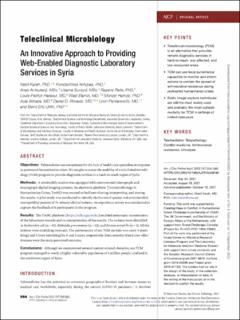| dc.contributor.author | Karah, Nabil | |
| dc.contributor.author | Antypas, Konstantinos | |
| dc.contributor.author | Al-Toutanji, Anas | |
| dc.contributor.author | Suveyd, Usama | |
| dc.contributor.author | Rafei, Rayane | |
| dc.contributor.author | Haraoui, Louis-Patrick | |
| dc.contributor.author | Elamin, Wael | |
| dc.contributor.author | Hamze, Monzer | |
| dc.contributor.author | Abbara, Aula | |
| dc.contributor.author | Rhoads, Daniel D. | |
| dc.contributor.author | Pantanowitz, Liron | |
| dc.contributor.author | Uhlin, Bernt Eric | |
| dc.date.accessioned | 2023-03-02T16:02:15Z | |
| dc.date.available | 2023-03-02T16:02:15Z | |
| dc.date.created | 2022-04-29T13:35:26Z | |
| dc.date.issued | 2022 | |
| dc.identifier.citation | American Journal of Clinical Pathology. 2022, 157 (4), 554-560. | en_US |
| dc.identifier.issn | 0002-9173 | |
| dc.identifier.uri | https://hdl.handle.net/11250/3055541 | |
| dc.description.abstract | Objectives: Telemedicine can compensate for the lack of health care specialists in response to protracted humanitarian crises. We sought to assess the usability of a teleclinical microbiology (TCM) program to provide diagnostic services in a hard-to-reach region of Syria.
Methods: A semimobile station was equipped with conventional micrograph and macrograph digital imaging systems. An electronic platform (Telemicrobiology in Humanitarian Crises, TmHC) was created to facilitate sharing, interpreting, and storing the results. A pilot study was conducted to identify the bacterial species and antimicrobial susceptibility pattern of 74 urinary clinical isolates. An experience survey was conducted to capture the feedback of 8 participants in the program.
Results: The TmHC platform (https://sdh.ngo/tmhc/) enabled systematic transmission of the laboratory records and co-interpretation of the results. The isolates were identified as Escherichia coli (n = 61), Klebsiella pneumoniae (n = 12), and Proteus mirabilis(n = 1). All the isolates were multidrug resistant. The performance of our TCM module was rated 4 (satisfying) and 5 (very satisfying) by 6 and 2 users, respectively. Data security of and cost-effectiveness were the main perceived concerns.
Conclusions: Although we encountered several context-related obstacles, our TCM program managed to reach a highly vulnerable population of 4 million people confined in the northwest region of Syria. | en_US |
| dc.language.iso | eng | en_US |
| dc.publisher | Oxford University Press | en_US |
| dc.rights | Navngivelse-Ikkekommersiell 4.0 Internasjonal | * |
| dc.rights.uri | http://creativecommons.org/licenses/by-nc/4.0/deed.no | * |
| dc.title | Teleclinical Microbiology: An Innovative Approach to Providing Web-Enabled Diagnostic Laboratory Services in Syria | en_US |
| dc.type | Peer reviewed | en_US |
| dc.type | Journal article | en_US |
| dc.description.version | publishedVersion | en_US |
| dc.rights.holder | © American Society for Clinical Pathology, 2021. | en_US |
| dc.source.pagenumber | 554-560 | en_US |
| dc.source.volume | 157 | en_US |
| dc.source.journal | American Journal of Clinical Pathology | en_US |
| dc.source.issue | 4 | en_US |
| dc.identifier.doi | 10.1093/ajcp/aqab160 | |
| dc.identifier.cristin | 2020155 | |
| cristin.ispublished | true | |
| cristin.fulltext | original | |
| cristin.qualitycode | 1 | |

